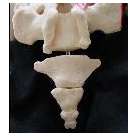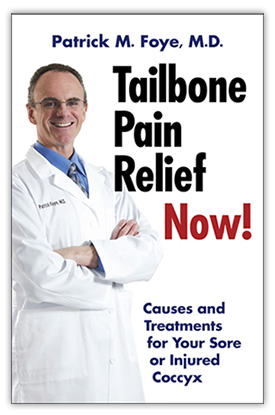On 9-24-16, Patrick Foye, M.D., Director of the Tailbone Pain Center (www.TailboneDoctor.com) gave a lecture to the APTANJ (American Physical Therapy Association of New Jersey) Women’s Health Special Interest Group (SIG) Meeting.
The lecture topic was “Coccyx pain: Overview for Pelvic Floor Physical Therapists.”
Approximately 20 pelvic floor physical therapists attended the 2-hour talk.
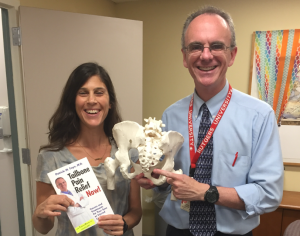 Niva Herzig, PT, with Patrick Foye, MD, after his lecture on Tailbone Pain. 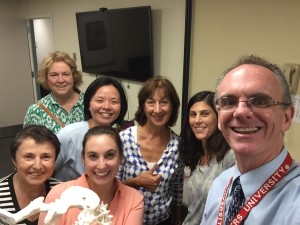 Dr. Foye with a few of the Pelvic Floor P.T.’s who attended the lecture on Tailbone Pain.  Dr. Patrick Foye at the APTANJ (American Physical Therapy Association of New Jersey) Women’s Health Special Interest Group (SIG) Meeting.
To come to Dr. Foye’s Tailbone Pain Center:
Tailbone Pain Book:
To get your copy of Dr. Foye’s book, “Tailbone Pain Relief Now!” click on this link: www.TailbonePainBook.com
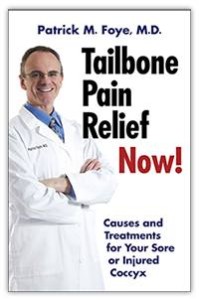 Book: “Tailbone Pain Relief Now! Causes and Treatments for Your Sore or Injured Coccyx” by Patrick Foye, M.D.
Image guidance for tailbone injections:
- The most important first step is for the treating physician to thoroughly assess for the CAUSE of the tailbone pain. In many ways, this can be more important then which type of injection is done and whether or not image-guidance is used for the injection. It is extremely important for the treating physician to assess for whether the tailbone pain is being caused by a bone spur at the lowest tip of the coccyx versus an unstable joint up at the highest end of the coccyx. Without such an evaluation, how would the physician know where to inject?
- Depending on what country you are in, image-guidance may or may not be available for your injection. In the United States, such injections are typically done using image-guidance. For example, I am located in New Jersey and I use image-guidance for almost all of the coccyx injections that I perform.
- There are different types of radiology methods for image guidance.
- Fluoroscopy: The most common method is fluoroscopy. Fluoroscopy is like immediate x-ray images that are displayed up on a computer screen. This allows the physician to see the target (the specific joint or bone spur or other abnormality where they want to place the injection). Fluoroscopy also allows the physician to see the tip of the needle, so that they can guide it to the best specific location.
- CT scans: CT (computerized tomography) is another method of image guidance for injections. Historically, CT scans are known as a source of substantial radiation to patients. Newer methods may allow the CT scan and to be done using less radiation, but it is still an area of concern.
- MRI (magnetic resonance imaging): there are a couple of research papers that talk about using MRI-guidance for coccyx injections. But MRI is extremely expensive compared to other methods.
- Ultrasound: in the future, ultrasound-guidance may have a significant role in performing tailbone injections. One limitation is that ultrasound can really only see the back wall of the coccyx, not being able to see past that bony surface. So it is limited at this time.
- Overall: Fluoroscopy is the most common method of image guidance for coccyx injections.
To come to Dr. Foye’s Tailbone Pain Center:
Tailbone Pain Book:
To get your copy of Dr. Foye’s book, “Tailbone Pain Relief Now!” click on this link: www.TailbonePainBook.com
 Book: “Tailbone Pain Relief Now! Causes and Treatments for Your Sore or Injured Coccyx” by Patrick Foye, M.D.
I will be speaking at the first-ever international coccyx pain symposium, being held in Paris, France on July 8-9, 2016.
Upcoming Tailbone Pain (Coccyx Pain) Symposium
To come to Dr. Foye’s Tailbone Pain Center:
Tailbone Pain Book:
To get your copy of Dr. Foye’s book, “Tailbone Pain Relief Now!” click on this link: www.TailbonePainBook.com
 Book: “Tailbone Pain Relief Now! Causes and Treatments for Your Sore or Injured Coccyx” by Patrick Foye, M.D.
There are a few different ways to approach your question about an association between tailbone (coccyx) problems and bowel problems. Sometimes it is the bowel problems causing tailbone symptoms, and sometimes it is the reverse where the coccyx problems are causing difficulties with the bowels. Let’s address these 2 categories separately below.
Bowel problems can cause pain in the coccyx region.
This can include things like:
- rectal cancer (malignancy),
- non-cancer masses/tumors behind the rectum (such as a rector rectal hamartomatosis tailgut cyst, etc.)
- perianal abscess (an infection around the anus)
- thrombosed hemorrhoids
- anal fissure
- proctitis
- coccyx irritation while passing a large bowel movement
- coccyx irritation during colonoscopy
- constipation can cause increased pressure on the tailbone region
Coccyx problems can cause problems/symptoms in the gastrointestinal (rectum, colon) region.
This can include:
- If the coccyx is abruptly angled too far forward, it can actually indent into the rectum.
- This can cause a perpetual feeling of bowel fullness.
- Also, during a bowel movement the movement of the stool within the rectum can press against the coccyx, causing worsening of the tailbone pain.
- If the patient has undergone a coccygectomy (surgical removal of the tailbone), one potential complication is prolapse (sagging) of the pelvic floor. When the pelvic floor is sagging the position of the rectum and anus is altered, which can create difficulty with controlling or passing bowel movements.
- Pain medications taken for tailbone pain (or other conditions) can cause constipation, internal bleeding within the stomach and intestines, etc.
Dr. Foye’s Top Tip on the topic of bowel/rectal problems and tailbone pain:
- Probably the most important thing to notice on this topic is whether the times when the tailbone pain is most severe do (or do not) match with bowel movements or bowel/rectal symptoms.
To come to Dr. Foye’s Tailbone Pain Center:
Tailbone Pain Book:
To get your copy of Dr. Foye’s book, “Tailbone Pain Relief Now!” click on this link: www.TailbonePainBook.com
 Book: “Tailbone Pain Relief Now! Causes and Treatments for Your Sore or Injured Coccyx” by Patrick Foye, M.D.
Last night I lectured on Tailbone Pain (Coccyx Pain) in Morris County, New Jersey.
Thank you to the Montville, New Jersey, public library for hosting the event in recognition of my recently published book: Tailbone Pain Relief Now!
There was a terrific turnout and I greatly enjoyed the question-and-answer session at the end of my talk.
Thank you to everyone who helped set up the event, and all those who came.
I will make arrangements for doing some online lectures and question/answer sessions in the near future.
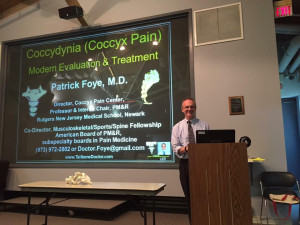
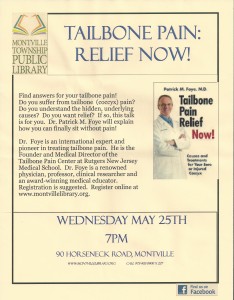 Announcing Tailbone Pain Coccyx Pain Lecture
To come to Dr. Foye’s Tailbone Pain Center:
Tailbone Pain Book:
To get your copy of Dr. Foye’s book, “Tailbone Pain Relief Now!” click on this link: www.TailbonePainBook.com
 Book: “Tailbone Pain Relief Now! Causes and Treatments for Your Sore or Injured Coccyx” by Patrick Foye, M.D.
Patients with tailbone pain (coccyx pain, coccydynia) sometimes ask me…
“After receiving medical radiation exposure (fluoroscopy, x-ray, etc.), how soon is it safe to get pregnant?”
How long after tailbone (coccyx) x-rays or fluoroscopy should I “wait” before getting pregnant?
- Here is information from the Health Physics Society (“a scientific organization of professionals who specialize in radiation safety.”)
-
“How long should I wait to conceive after x-ray exams that have exposed my ovaries or my husband’s testes? Can I become sterile after having x rays? ANSWER: There is no evidence that there are any effects on the ovaries or sperm at doses used in diagnostic procedures such as the one(s) you had. If there were any risk at all, it would be very small. Also, this type of radiation does not remain in your body so that does not need to be a concern either.” Source: http://hps.org/publicinformation/ate/faqs/pregnancyandradiationexposure.html
-
“How long should I wait to try to become pregnant after x-ray exams that have exposed my ovaries or my husband’s testes? Can I become sterile after having x rays? ANSWER: There is no evidence of effects on the ovaries or sperm at radiation doses used in diagnostic x-ray procedures. Radiation doses from routine medical x rays are too small to affect sterility or have an effect on a future pregnancy. Therefore, you do not need to wait after diagnostic x-ray exams before trying to become pregnant.” Source: http://www.radiationanswers.org/radiation-questions-answers/radiation-and-pregnancy.html
To come to Dr. Foye’s Tailbone Pain Center:
Tailbone Pain Book:
To get your copy of Dr. Foye’s book, “Tailbone Pain Relief Now!” click on this link: www.TailbonePainBook.com
 Book: “Tailbone Pain Relief Now! Causes and Treatments for Your Sore or Injured Coccyx” by Patrick Foye, M.D.
You are invited to attend…
Free lecture on Tailbone Pain (Coccyx Pain).
- By Patrick Foye, M.D., Director of the Tailbone Pain Center.
- When: Wednesday, May 25, 2016, at 7:00 pm
- Where: Montville N.J. Public Library
(Morris County, New Jersey, United States)
90 Horseneck Rd, Montville, NJ 07045
- Phone:-extension-227
- For Free registration, click here.

To come to Dr. Foye’s Tailbone Pain Center:
Tailbone Pain Book:
To get your copy of Dr. Foye’s book, “Tailbone Pain Relief Now!” click on this link: www.TailbonePainBook.com
 Book: “Tailbone Pain Relief Now! Causes and Treatments for Your Sore or Injured Coccyx” by Patrick Foye, M.D.
Which is better when evaluating tailbone pain (coccyx pain), an MRI or a CT scan?
- CT scan can be very good at showing bone, but MRI can show not only bone but ALSO give good definition of soft tissue structures.
- Some of the soft tissue structures that show up clearly on MRI include:
- abscess (which is essentially an infection like a pocket/collection of pus)
- pilonidal cyst
- other fluid collections or areas of inflammation
- soft tissue malignancies
- other soft tissue masses [e.g., retrorectal hamartoma, which is a mass that happens behind the rectum and immediately in front of the sacrum and coccyx],
- fluid/inflammation within the bones (e.g., due to osteomyelitis = bone infection, which can especially occur after bed sores [pressure ulcers] or surgical removal of the elbow and [coccygectomy].
- MRI is more expensive than CT scan
- so insurance companies usually require people/doctors to go through more hurdles to get an MRI rather than a CT scan.
- Radiation risks:
- Also, CT scans unfortunately deliver radiation to the patient, whereas MRI delivers no such radiation.
- Either can be helpful:
- For all these reasons, I generally prefer MRI instead of CT scans.
- I do order CT scans sometimes, but usually it is in those where the MRI can not be done (due to metal in the patient that can prevent putting them in the MRI magnet), or if the MRI shows something that needs a different type of clarification, etc.
To come to Dr. Foye’s Tailbone Pain Center:
Tailbone Pain Book:
To get your copy of Dr. Foye’s book, “Tailbone Pain Relief Now!” click on this link: www.TailbonePainBook.com
 Book: “Tailbone Pain Relief Now! Causes and Treatments for Your Sore or Injured Coccyx” by Patrick Foye, M.D.
- MRI and CT scans take images similar to taking a series of slices.
- Imagine a block of cheese on a slicing machine in a delicatessen. You could slice the block of cheese from left to right, from top to bottom, or from front to back.
- In medical imaging, there are different terms for these different types of slices:
- Slices from left to right (such as a vertical slice that appears to split the body into a right side and the left side): These are “sagittal” views.
- Slices from top to bottom (e.g. in the standing position this would be like taking a horizontal slice up at the level of the head, another at the level of the neck, another at the level of the chest/torso, another at the abdomen, another of the pelvis, of course in reality would be multiple such slices at any such given level): These are “axial” views.
- Slices from front to back: These are “coronal” views.
- In general, the sagittal views are usually the most helpful for looking at coccyx anatomical abnormalities.
- THIN sections: Another factor is that MRI of the coccyx needs to be done using multiple thin sagittal slices at the midline, otherwise it is possible that there would be no slice (image) right at the level of the coccyx.
- That is especially important for the lower coccyx, since that is the thinnest, most-narrow part of the coccyx.
- On standard MRI images there are relatively “thick” slices. With those thick slices it can sometimes occur that one slice (image) is just to the right of the coccyx and the very next image is just to the left of the coccyx, thus missing (skipping over) the bone of interest (the coccyx).
To come to Dr. Foye’s Tailbone Pain Center:
Tailbone Pain Book:
To get your copy of Dr. Foye’s book, “Tailbone Pain Relief Now!” click on this link: www.TailbonePainBook.com
 Book: “Tailbone Pain Relief Now! Causes and Treatments for Your Sore or Injured Coccyx” by Patrick Foye, M.D.
Proving that a tailbone problem even exists
- Do you have a lawsuit related to your tailbone injury (coccyx injury)?
- The first step in a legal case involving a tailbone injury or coccyx pain would be proving that a tailbone problem actually exists.
- The legal system is generally based on evidence. Subjective factors like self-reported symptoms might get some consideration, but typically more consideration is given to “objective evidence” that essentially “proves” that there is a tailbone problem or injury.
- Examples of subjective, self-reported symptoms include your own statements about
- the pain that you feel,
- the difficulties that you have with sitting on certain surfaces, etc.
- Examples of objective evidence include:
- abnormalities that the physician documents from performing a careful and thorough physical examination
- abnormalities on x-rays
- coned-down x-ray views of the coccyx
- sitting-versus-standing x-rays of the coccyx are especially helpful. Without this type of x-rays, a large percentage of tailbone injuries will fail to be diagnosed. Without these sitting x-rays the abnormality will be missed, unrecognized, thus weakening your legal case.
- abnormalities on MRI
- abnormalities on CT scans
- abnormalities on bone scans
Causality: proving that a specific incident caused your tailbone injury
- Factors that support the notion that a specific incident caused your tailbone injury:
- No tailbone injuries or tailbone pain prior to the incident in question
- No unrelated medical explanation for your tailbone pain (e.g., the symptoms are not being caused by a pilonidal cyst or a tailbone malignancy).
- Tailbone symptoms reported relatively soon after the incident (admittedly this is sometimes difficult because patients may initially report general low back pain or buttock pain, so it may not initially be clearly understood that the pain is coming from the tailbone)
- No previous imaging studies showing that the tailbone abnormality already existed prior to the incident in question.
Book Chapter on Legal Cases for Tailbone Injuries
- My book, Tailbone Pain Relief Now! has an entire chapter on Legal Cases for Tailbone Injuries.
- That chapter covers some of the challenges in getting objective evidence confirming the coccyx injury, establishing “causality” (i.e., that a specific injury caused the coccyx problems), etc.
- If you are in the United States, you can get a copy of my book for free (just pay the shipping/handling) at www.TailbonePainBook.com
- If you are outside of the United States, you can get the book on Amazon at: Tailbone-Pain-Book-on-Amazon
Determining Financial Compensation for a Tailbone Injury
- It can be challenging to come to a specific dollar amount for financial compensation for a tailbone injury.
- You probably should discuss that with an attorney who has expertise in the area of law that this applies
- if this is a workplace injury then find an attorney who represents injured workers,
- if this was from an automobile injury then find an attorney who represents auto accident victims
- Presumably they would need to take into account:
- medical costs: doctor’s visits, prescription medications, over-the-counter medications, tailbone injections, surgery (coccygectomy), etc.
- lost work time: how much time did you miss from work due to this injury? Include days missed for medical appointments, etc.
- long-term disability (if any)
- Total disability:
- Total disability means your totally unable to return to any type of work.
- Compensation for total disability may include consideration for how many years of work you will lose.
- if we roughly assume that people retire at 65…
- then if you went out of work at age 60 you only lost five years of paid employment
- if you went out of work at age 30 then you have lost 35 years of paid employment.
- “Partial” disability:
- Partial disability means that you are not able to do all of the same work that you did before.
- Maybe you are not able to do the same type of job you did before, but you can work doing something else.
- Perhaps you can no longer do a sitting job like driving a bus or flying a plane, but you can do a different type of work that does not require such prolonged sitting.
- Maybe you can do the same type of job you did before, but due to decreased sitting tolerance you can only sit for long enough to work part time, instead of full time.
- Your financial loss from the tailbone injury might take into consideration whether your new job or part-time status results in a lower yearly income than the work that you were able to do prior to the tailbone injury.
Finding an attorney
- Consider using Google or another search engine to find an attorney in your geographic area who specializes in the type of case that you have.
- For example:
- Auto injury attorney in Seattle
- Injured worker attorney in Chicago
- Read reviews about the attorney online.
- Some attorneys will give a free consult so you can see if they are a good fit for you and your case.
- Attorneys may work on commission, meaning that they keep a percentage of what is awarded. The hope then would be that having the attorney involved increases the award enough to have made it worthwhile to have involved the attorney.
To come to Dr. Foye’s Tailbone Pain Center:
Tailbone Pain Book:
To get your copy of Dr. Foye’s book, “Tailbone Pain Relief Now!” click on this link: www.TailbonePainBook.com
 Book: “Tailbone Pain Relief Now! Causes and Treatments for Your Sore or Injured Coccyx” by Patrick Foye, M.D.
|
Book Now Available! Click on the book to get it now:
|


